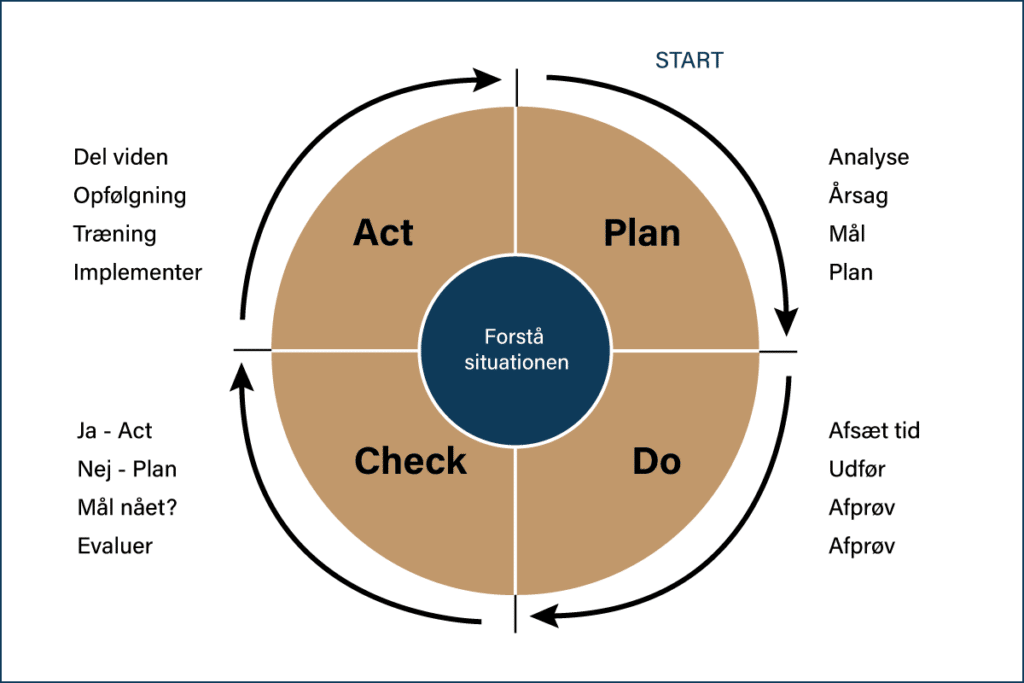In many organizations, there are good intentions to work on quality improvement. In order to succeed, it is necessary to work systematically on how to create improvements. Here, the improvement model is an excellent tool that can help you ensure that initiated improvement initiatives also lead to improvements. This article introduces you to the model.
Decoupled quality development is rarely successful
You know the feeling. You've noticed that there's a workflow that isn't working optimally in the workplace, or a service you're delivering that's not up to scratch. In both cases, you know you need to do something different. For example, you may be the head of the municipal home nursing service and you've noticed in a random sample that there are too many dosing errors when your nurses dose medicine to citizens. Or you are the head of a case management unit in the police and you find that the prosecution's lawyers are returning many of the cases that your employees have handled. Simply because the case processing quality is too poor for the cases to be heard in the district court. It may also be that you are a school principal and you find in the student satisfaction survey that too many of the school's students are unhappy in their daily lives as a result of bullying. Similarly, you can probably think of an example from your workplace that involves a need to work on quality improvements in one way or another.
Typically, the work on quality improvement has been carried out in such a way that guidelines in the form of e.g. plans, case handling guides, action cards or similar are drawn up at the desks in the administration or quality department. The guidelines are then approved by management and sent out to the organization. It is then expected that the new initiatives will be implemented and create the intended improvements. However, this approach, where the work on quality development is disconnected from the practice where the quality development is to take place, is rarely very effective. This is where the improvement model comes into the picture as the solution that ensures that quality improvement work is based on the reality where the improvement is to be created. The model also allows for continuous learning and adaptation based on a close assessment of the desired effects of the initiatives that are initiated.
Read more about our training
Want to be even better equipped to manage processes?
The Process Consultant program gives you the methods to design, facilitate and lead strategic development processes and changes to create the impact you need.
This is an education for those who work with development, processes and change management.
The Improvement Model: A proven method for quality improvement
The improvement model is a proven method for quality development, originally developed in the early 1990s by the Institute for Healthcare Improvement in the US. The model has since been described in several books and has become a core tool for quality improvement, especially in healthcare. As with the traditional approach, the improvement model starts by sitting down at the desk and drafting a proposal for the specific actions that need to be taken to improve quality. But before you immediately approve these actions, you go out into practice and test and adapt these actions using PDSA, which you'll be introduced to in a moment. Only when you have tested and adapted the individual measures and found out which ones in particular contribute to quality improvements, these measures are approved by management and then rolled out throughout the organization.
The improvement model is a simple yet highly effective method for accelerating change and improvement processes. The improvement model consists of two parts: three questions and a working method for testing actions and learning from the tested actions.
Three questions and a working methodology are the core of the improvement model
The three questions you need to address are:
- What do we want to achieve?
- How do we know a change is an improvement?
- What changes need to be made to drive improvements?
The working method is called PDSA, which stands for Plan-Do-Study-Act. PDSA is the catalyst of the improvement model, ensuring that ideas are turned into concrete actions. Next, PDSA creates learning from the tested concrete actions and is used to build knowledge that can serve as a starting point for testing and introducing new actions.
Question 1: What do we want to achieve?
Of course, before you launch a bunch of initiatives in your workplace, it's necessary to first consider what you want to improve. The first task is to set a clear and defined goal for what you want to achieve. This may seem trivial, but can actually be difficult in practice. If the goal is not well-defined, it can be difficult to know what actions to test and implement, and it can be challenging to measure whether the changes have actually contributed to improvements.
It will therefore be beneficial if you can successfully set numerical targets for the improvements you want to achieve and also set a timeframe for the realization of the target. According to the initial examples, the goals could be:
- At the next random check on June 1, 2022, a maximum of 5 percent of citizens may have received incorrectly dosed medication.
- By March 1, 2022, the return rate of poorly processed cases must be reduced from 25 percent to 10 percent.
- When the results of next year's student well-being survey are available in April 2022, the proportion of children who report that they are "very much" unhappy as a result of bullying should be reduced to 5 percent.
Question 2: How do we know when a change is an improvement?
Sometimes it's easy to observe whether or not an improvement has taken place - other times it requires advanced measurements. Either way, it's necessary to have some indicators that can tell if the improvements are happening and the targets are close to being met. Here we can further distinguish between outcome indicators, which say something about the quality of the service, and process indicators, which say something about the quality of the workflows that lead to the outcome.
In relation to the medication dosage example, a performance indicator could be the number of incorrectly dosed citizens in the municipality's home nursing care, while a process indicator could be the proportion of the municipality's citizens receiving medication dosage that are included in the sample. Here you should be careful to limit the number of indicators to an absolute minimum.
Question 3: What changes need to be made to drive improvements?
Now it's time to start thinking about what specific actions you want to take that you think will help you achieve the goal you've set. In the improvement model, these actions are referred to as improvement ideas. In the example of medication dosing, the improvement ideas could be, for example:
- Training SOSU assistants and SOSU caregivers in medication dosing
- Rules that high-risk medications - such as blood thinners - can only be handled by nurses
- Possibility for the coordinating nurse to assign double time for medication dosing if the patient receives a large number of different medications that increase the risk of dosing errors
The PDSA method - trial actions for clarification
Once you've answered the third question above, you'll have a rough list of improvement ideas that you expect will contribute to the goals you identified in the first question. In order to translate these ideas into concrete actions and assess their usefulness, you need to use the PDSA methodology.
The starting point in PDSA is that you start by developing a hypothesis. In relation to the above, a hypothesis could for example be: "If we train healthcare assistants and healthcare aides in medication dosing, errors in medication dosing will decrease." Here, it is often beneficial to formulate a hypothesis that can be answered yes/no, because it clarifies what you are testing.
Next, the hypothesis needs to be tested in practice. An important point to note here is that you should try to test the hypothesis on as small a scale as possible. In relation to the above, this could mean, for example, that you start by teaching 1 SOSU assistant. Then let the experience gained from this trial run form the basis for adaptations and small adjustments to the trial run. For example, it could be that there is a need to change the teaching content - and let this be the starting point for new test actions.
FOCUS ON THE AGILE ORGANIZATION AND YOUR PERSONAL LEADERSHIP
Agile leadership is about adapting your leadership and organization to the task at hand. A crucial skill to succeed in your role as a leader today - and in the future
Through our Agile Leadership course, you'll gain knowledge and training in a range of essential tools to strengthen your day-to-day management.
Start testing small
In other words, the idea is that you start with small-scale testing until you have found an optimal solution that works in practice. Only then is the measure fully implemented in, for example, the entire home care sector. The advantage of small-scale testing is that it speeds up the learning and implementation process, limits any unforeseen adverse effects, and allows you to quickly discard poorly performing measures without using unnecessary resources.
Once you've done enough small-scale testing and made the necessary adjustments along the way, you can try testing on a slightly larger scale. In relation to the previous example, this could be testing the training for an entire team and then for an entire department, or testing both physical and virtual training. This way, you can test and pressure test your approach under different conditions, ensuring that only the best ideas survive and increasing the likelihood that the change will lead to continuous improvement.
Points to consider when using PDSA
Plan: Once you've decided what to test, plan in detail what will be tested, who will be responsible for the testing, and where and when the testing will take place:
"Karen is teaching 1 employee from outreach team 4 in medication dosing in the lunchroom on Monday from 12-14."
Do: Conduct the above test. After the test, collect data that answers the hypothesis you have formulated. Did the test have the expected effect? According to the above example, the trainer could, for example, ask the participant about her immediate learning outcomes after the training, and in the days following, random checks could be made of the number of medication dosing errors in team 4, comparing the error rate of the employee who received the training compared to the other employees in the team.
Study: Next, you analyze the collected information. Was the hypothesis confirmed? Here you also consider which parts of the initiative worked well and which parts didn't. Based on this, consider what worked so well that you can immediately decide to implement it. At the same time, you also consider what worked so poorly that it can be discarded immediately. Finally, consider what needs to be tweaked and adjusted, which then needs to be tested in another PDSA cycle.
Act: Based on the analysis, you now decide what the next step should be. For example, if the training worked well physically, try running it virtually. If running the training in the morning worked, try running it in the evening. If it worked well with an experienced employee, try it with a new graduate. If you're unsure if the training will work with more participants, try increasing the number of participants. The list goes on and on, as one PDSA will often generate ideas for more PDSAs. The trick is to break down ideas into suitably small elements that can be tested individually. This way, you can run several tests simultaneously, which contributes to a lot of learning, but also to the quick and efficient realization of the desired quality improvement.
Based on the above, you have a starting point for working with quality development - and here, two PDSA rules of thumb can help you remember the purpose of the improvement model and the point that you should always start with small-scale trial actions. PDSA is also known as "Trial Actions that Create Clarification" and "Try It Small".
Have fun with the improvement work!
Example: Designing a strategy process
The Plan-Do-Study-Act circle (PDSA). An improvement model for turning ideas into concrete actions. PDSA creates learning and is used to build knowledge and test and implement change.




